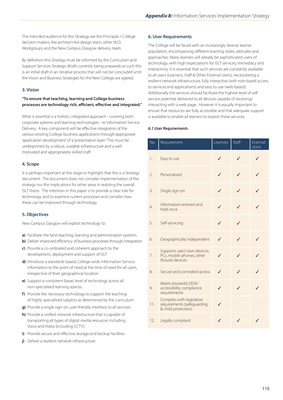
Appendix 8: Information Services Implementation Strategy
115
The intended audience for this Strategy are the Principals / College
decision makers, the architect-led design team, other NCG
Workgroups and the New Campus Glasgow delivery team.
By dei nition this Strategy must be informed by the Curriculum and
Support Services Strategic Briefs currently being prepared; as such this
is an initial draft in an iterative process that will not be concluded until
the Vision and Business Strategies for the New College are agreed.
3. Vision
"To ensure that teaching, learning and College business
processes are technology rich, ei cient, ef ective and integrated."
What is essential is a holistic, integrated approach - covering both
corporate systems and learning technologies - to Information Service
Delivery. A key component will be ef ective integration of the
various existing College business applications through appropriate
'application development' of a 'presentation layer'. This must be
underpinned by a robust, scalable infrastructure and a well
motivated and appropriately skilled staf .
4. Scope
It is perhaps important at this stage to highlight that this is a Strategy
document. The document does not consider implementation of the
strategy nor the implications for other areas in realising the overall
ISLT Vision. The intention in this paper is to provide a clear role for
technology and to examine current processes and consider how
these can be improved through technology.
5. Objectives
New Campus Glasgow will exploit technology to:
a) Facilitate the best teaching, learning and administration systems
b) Deliver improved ei ciency of business processes through integration
c) Provide a co-ordinated and coherent approach to the
development, deployment and support of ISLT
d) Introduce a standards based, College-wide Information Service:
information to the point of need at the time of need for all users,
irrespective of their geographical location
e) Support a consistent (base) level of technology across all
non-specialised learning spaces.
f) Provide the necessary technology to support the teaching
of highly specialised subjects as determined by the curriculum
g) Provide a single sign-on, user-friendly interface to all services
h) Provide a unii ed network infrastructure that is capable of
transporting all types of digital media resources including
Voice and Video (including CCTV)
i) Provide secure and ef ective storage and backup facilities
j) Deliver a resilient network infrastructure
6. User Requirements
The College will be faced with an increasingly diverse learner
population, encompassing dif erent learning styles, attitudes and
approaches. Many learners will already be sophisticated users of
technology, with high expectations for ISLT services, immediacy and
interactivity. It is essential that such services are constantly available
to all users (Learners, Staf & Other External Users), necessitating a
resilient network infrastructure, fully interactive (with role-based access
to services and applications) and easy to use (web based).
Additionally the services should facilitate the highest level of self
service potential delivered to all devices capable of receiving/
interacting with a web page. However it is equally important to
ensure that resources are fully accessible and that adequate support
is available to enable all learners to exploit these services.
6.1 User Requirements
No. Requirement Learners Staf External
Users
1. Easy to use ✓✓✓
2. Personalised ✓✓✓
3. Single sign-on ✓✓✓
4.
Information entered and
held once
✓✓✓
5. Self-servicing ✓✓
6. Geographically independent ✓✓✓
7.
Supports users' own devices:
PCs, mobile phones, other
(future) devices
✓✓✓
8. Secure and controlled access ✓✓✓
9.
Meets (exceeds) DDA/
accessibility compliance
requirements
✓✓✓
11.
Complies with legislative
requirements (safeguarding
& child protection)
✓
12. Legally compliant ✓✓✓